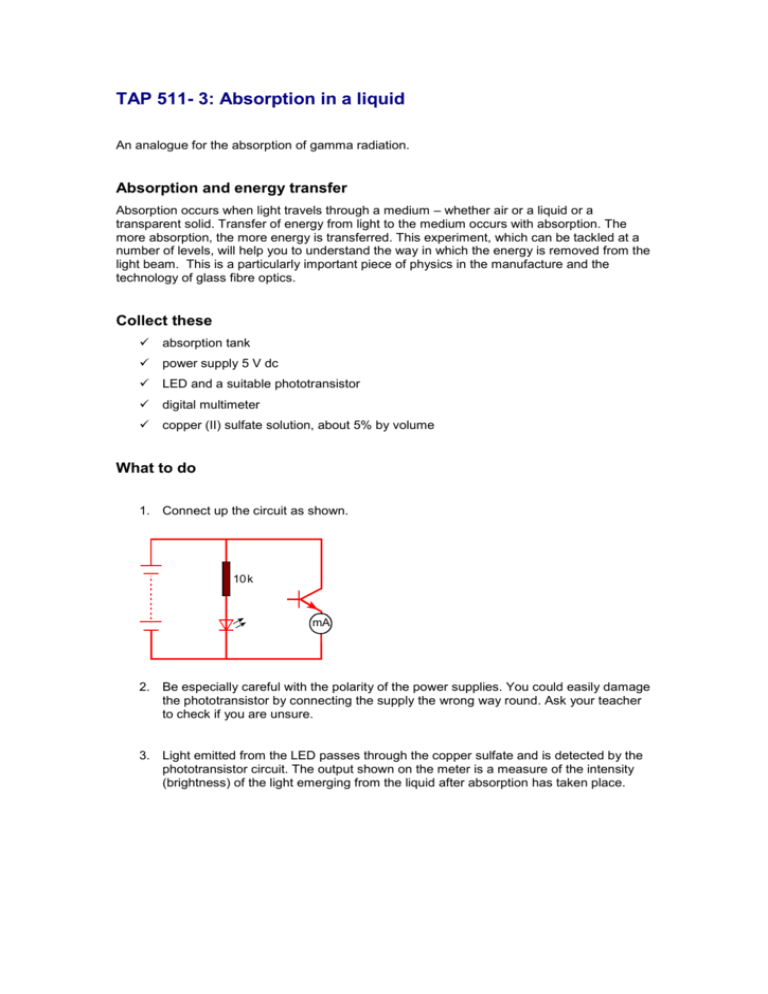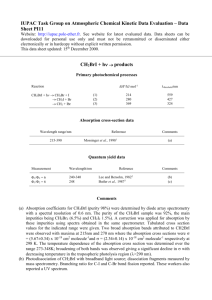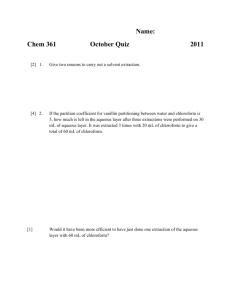TAP 511- 3: Absorption in a liquid
advertisement

TAP 511- 3: Absorption in a liquid An analogue for the absorption of gamma radiation. Absorption and energy transfer Absorption occurs when light travels through a medium – whether air or a liquid or a transparent solid. Transfer of energy from light to the medium occurs with absorption. The more absorption, the more energy is transferred. This experiment, which can be tackled at a number of levels, will help you to understand the way in which the energy is removed from the light beam. This is a particularly important piece of physics in the manufacture and the technology of glass fibre optics. Collect these absorption tank power supply 5 V dc LED and a suitable phototransistor digital multimeter copper (II) sulfate solution, about 5% by volume What to do 1. Connect up the circuit as shown. 10k mA 2. Be especially careful with the polarity of the power supplies. You could easily damage the phototransistor by connecting the supply the wrong way round. Ask your teacher to check if you are unsure. 3. Light emitted from the LED passes through the copper sulfate and is detected by the phototransistor circuit. The output shown on the meter is a measure of the intensity (brightness) of the light emerging from the liquid after absorption has taken place. water phototransistor LED copper sulphate 4. Slide the tank between the light source and detector at 90 to the direction in which the light is shone. By sliding the tank in this way you can vary the thickness of copper (II) sulfate solution through which the light travels and therefore assess the loss of intensity. 5. Plot a graph of meter reading (a measure of intensity, remember) against solution thickness. 6. You can take this analysis as far as you wish: Is there an obvious rule which describes the variation shown in your graph? Have you met such a rule in science before? (Hint: how does the radioactive count-rate change when a radioactive isotope decays?) Why does this rule apply? 7. Find out how thick the liquid has to be to absorb half the light. 8. Could you simulate the absorption experiment here on a computer or a calculator? (Hint: imagine that there are 100 units of light energy coming out of the light and that every 0.1 mm 1% of the energy remaining is removed. How much is left after the first 0.1 mm, answer: 99 units, after 0.2 mm 99% of 99 units [0.9801 units], after 0.3 mm 99% of 99% of 99 units [0.9703 units]. Use a spreadsheet to carry out this tedious calculation for 100 mm, 200 mm, 300 mm, and so on.) The relationship between amount of light absorbed and thickness of absorbing medium Light is absorbed when it passes through a medium – however transparent it appears to be. A constant fraction of the incident light is removed per unit distance travelled. Mathematically, this is known as an exponential relationship. Radioactive decay is another phenomenon involving an exponential relationship – leading to the idea of half-life of an isotope, the time taken for half the number of radioactive atoms in a sample to decay. In a similar way we can think of a 'half-distance', in light absorption, over which half the light is absorbed. Practical advice The light-absorbing properties of materials are not required by the specification, but this may be of interest to some students. The equipment needed here is easy to build. It requires a phototransistor and a light-emitting diode. The circuit is shown in the diagram(s). One power supply will suffice for both halves of the circuit. The LED and transistor need to face each other across a gap of perhaps 10-12 cm. In trials the devices were rigidly mounted as shown in the diagram, but they could be free standing. This, however, needs careful alignment. In the gap sits a rectangular tank of dimensions 10 cm x 30 cm. These dimensions are not critical. A vertical barrier separates the two halves of the tank. One half is filled with water, the other half with the 5% (w/v) copper (II) sulfate solution. The arrangement is known as a Bjerrum wedge and is used for colorimetric measurements. Students slide the wedge between the light source and detector. They measure output as a function of sulfate solution thickness. Some adjustment of solution strength may be needed. Alternative approaches Ghost tape provides an appropriate reduction intensity for some light sources and sensors (TLS 250 and a 36 W lamp). Here discrete values of tape enable exponential thinking to get to grips with the problem. If one piece lets through X%, then two pieces will let through X% squared, etc Social and human context Fibre optics has only become possible because of the huge advances in the manufacture of low attenuation glasses. Safety Copper sulfate solution can be harmful. At this concentration, no washing label is required. If you get the solution on your hands or elsewhere wash it off immediately External reference This activity is taken from Advancing Physics chapter 4, 240E




